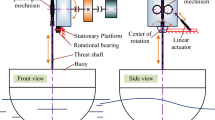Abstract
According to Newton’s Second Law and the microwave theory, mechanical analysis of multiple buoys which form Sharp Eagle wave energy converter (WEC) is carried out. The movements of every buoy in three modes couple each other when they are affected with incident waves. Based on the above, mechanical models of the WEC are established, which are concerned with fluid forces, damping forces, hinge forces, and so on. Hydrodynamic parameters of one buoy are obtained by taking the other moving buoy as boundary conditions. Then, by taking those hydrodynamic parameters into the mechanical models, the optimum external damping and optimal capture width ratio are calculated out. Under the condition of the optimum external damping, a plenty of data are obtained, such as the displacements amplitude of each buoy in three modes (sway, heave, pitch), damping forces, hinge forces, and speed of the hydraulic cylinder. Research results provide theoretical references and basis for Sharp Eagle WECs in the design and manufacture.
Similar content being viewed by others
References
Bhatta, D.D. and Rahman, M., 2003. On scattering and radiation problem for a cylinder in water of finite depth, International Journal of Engineering Science, 41(9), 931–967.
Calisal, S.M. and Sabuncu, T., 1984. Hydrodynamic coefficients for vertical composite cylinders, Ocean Engineering, 11(5), 529–542.
Chen, A.J., You, Y.G., Sheng, S.W. and Peng, W., 2014a. Damage analysis of eagle wave energy converter in rotating-collision, Advances in New and Renewable Energy, 2(2), 129–134. (in Chinese)
Chen, A.J., You, Y.G., Sheng, S.W. and Peng, W., 2014b. Study on the structural damage of the eagle type wave energy converter due to the rotating-collision process, Journal of Ocean Technology, 33(4), 6–11. (in Chinese)
Feng, P.Y., Ma, N. and Gu, J.C., 2013. Research on wave energy recovery by oscillating wings for energy efficient ship propulsion, Journal of Ship Mechanics, 17(9), 1021–1030.
Kaye, D. and Maull, D.J., 1993. The response of a vertical cylinder in waves, Journal of Fluids and Structures, 7(8), 867–896.
Kurniawan, A., Pedersen, E. and Moan, T., 2012. Bond graph modelling of a wave energy conversion system with hydraulic power takeoff, Renewable Energy, 38(1), 234–244.
Morison, J.R., Johnson, J.W. and O’Brien, M.P., 1953. Experimental studies of forces on piles, Coastal Engineering Proceedings, 1(4), 25.
Qin, L. and Wu, B.J., 2013. Oscillating properties of a wave energy device consisting of double cylindrical floats, Journal of Ship Mechanics, 17(11), 1253–1261. (in Chinese)
Sabuncu, T. and Calisal, S., 1981. Hydrodynamic coefficients for vertical circular cylinders at finite depth, Ocean Engineering, 8(1), 25–63.
Sheng, S.W., You, Y.G. and Wang K.L., 2013. Research on 10kW sharp eagle wave energy convertor, The 2nd Session of the China Marine Renewable Energy Development Forum Annual Meeting Proceedings, National Ocean Technology Center, Guangzhou, 378–384. (in Chinese)
Sheng, S.W., You, Y.G. and Wang, K.L., 2014. Research and Development of Sharp Eagle Wave Energy Convertor, Report of 5th International Conference on Ocean Energy, Halifax, Canada.
Wang, K.L., Sheng, S.W., You, Y.G., Zhang, Y.Q., Jiang, J.Q., Lin, H.J. and Ye, Y., 2014. Research on the redundancy monitoring system of the “Sharp Eagle No.l” floating wave energy converter, Journal of Ocean Technology, 33(4), 62–67. (in Chinese)
Yang, L.M. and Moan, T., 2011. Dynamic analysis of wave energy converter by incorporating the effect of hydraulic transmission lines, Ocean Engineering, 38(16), 1849–1860.
Zhang, Y.Q., Sheng, S.W., You Y.G., Wang, Z.P., Wang, K.L, and Lin, H.J., 2014. Experimental study on a 100 kW one-base multibuoy floating “Sharp Eagle” wave energy converter, Journal of Ocean Technology, 33(4), 73–80. (in Chinese)
Zhao, H.T. and Shen, J.F., 2013. An experimental study on hydrodynamic performance of a bottom-hinged flap wave energy converter, Journal of Ship Mechanics, 17(10), 1097–1106. (in Chinese)
Author information
Authors and Affiliations
Corresponding author
Additional information
Foundation item: This work was financially supported by the National Natural Science Foundation of China (Grant No. 41406102) and the Special Foundation for Ocean Renewable Energy (Grant No. GHME2016YY01).
Rights and permissions
About this article
Cite this article
Zhang, Yq., Sheng, Sw., You, Yg. et al. Study of hydrodynamic characteristics of a Sharp Eagle wave energy converter. China Ocean Eng 31, 364–369 (2017). https://doi.org/10.1007/s13344-017-0043-0
Received:
Revised:
Accepted:
Published:
Issue Date:
DOI: https://doi.org/10.1007/s13344-017-0043-0




